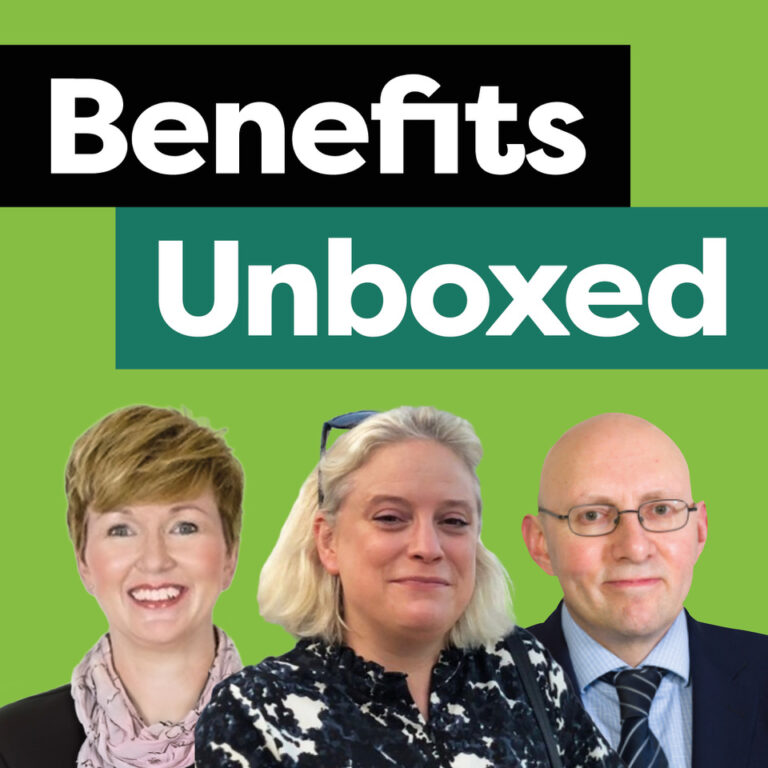Greater awareness of neurodiversity alone won’t plug the employment gap, say inclusion experts. So how can employers attract and retain neurodivergent talent through more inclusive reward and benefits strategies? Grace Lewis speaks to experts and employers PwC and Virgin Media O2 about putting neuroinclusion into practice.
Estimates show that more than 15 percent of UK adults have a neurodivergent condition, including ADHD, autism, dyslexia, dyspraxia, and Tourette’s Syndrome. However, government figures suggest that just 31 percent of people with a neurodiversity are in employment compared to 54.7 percent of disabled people overall. This is eight times the unemployment rate for neurotypical people.
In an effort to plug this gap, in January 2025, the DWP launched an independent panel of academics to advise the government and employers on boosting neurodiversity awareness and inclusion at work. The panel is expected to publish their findings in the coming months.
But Lisa Barclay, PhD candidate at Henley Business School, says employers don’t have to wait. “Neurodiversity has become an increasingly important dimension of workplace diversity, with awareness rising rapidly in recent years,” she says.
“Research highlights its impact not only on individual wellbeing and performance, but also on organisational success.”
This is not lost on HR leaders. A survey from employee benefits platform Zest found that 35 percent of HR leaders said neurodiverse employees boost productivity. A similar proportion (31 percent) reported that this has led to higher profits.
Barclay adds: “Neurodivergent employees often contribute unique strengths, such as creativity, attention to detail, and innovative problem-solving, while intersecting identities, such as gender or race, can add further depth to these contributions.
“Beyond organisational gains, however, the broader societal value of creating meaningful, paid employment opportunities for all individuals should also be recognised.”
For Tom Vodden, business psychologist and organisational development consultant, the drivers for employers wanting to become more neuroinclusive go beyond CSR and ESG, as he highlights compliance, recruitment and retention.
But if efforts to be more neuroinclusive are only being made for compliance reasons, they risk becoming a box-ticking exercise, he warns.
Prioritise neuroinclusion
One sector exploring how to become more neurodiverse is pensions. As a cornerstone of employee benefits, changes in this sector could have a much wider knock on effect on neuroinclusion.
Sophia Singleton, president of the Society of Pension Professionals (SPP), says: “Nearly three quarters of SPP’s members (73 percent) think diversity, equity and inclusion should be a ‘top priority’ or ‘priority’ policy objective for the SPP, so [greater neuroinclusion] is a great way of demonstrating our commitment to that while also raising awareness and understanding in both the pensions and broader business worlds.”
SPP recently collaborated with neurodiversity support body The Donaldson Trust to publish a paper examining how to make this happen. In it experts outline how to make pension benefits more accessible too.
Recommendations include clear, accessible communication, especially for complicated and often jargon-heavy pensions information.
“Use plain language and break down information into small, digestible steps. Replace lengthy brochures with short, easy-to-follow guides that allow people to learn at their own pace,” the paper says.
It’s practical advice for neuroinclusion that applies to pension communications more widely.
There is evidence of organisations adapting their standard recruitment practices to attract a wider, more diverse community (See case studies from PWC and Virgin Media O2 below). Riaan van Wyk, senior consultant at Barnett Waddingham says benefits are integral to this.
“Employee benefits can play a part in establishing an employee value proposition that speaks to neurodiverse candidates by creating a safe working environment where there is support and awareness of neurodiversity.”
Barnett Waddingham research shows that neurodivergent individuals are more prone to suffer, or have suffered, from issues related to mental health when compared to neurotypical individuals. In light of this, van Wyk suggests providing adequate mental health support to help neurodiverse individuals to feel seen and valued.
The key is then advertising the benefits from the off, and continuing to engage with all employees with regular line manager catch ups and signposting to the benefits on offer throughout the employee lifecycle.
Vodden stresses the importance of engaging all employees in designing packages that will incentivise, motivate and reward them in their own ways: “How many organisations, when they are introducing a reward system or benefits scheme, actually take the time to engage their employees in that conversation and ask them what they want? Ask them what is going to work for them?”
Financial incentives and the offer of CBT under private healthcare, for example, might not be top priority for neurodivergent talent, he says. Whereas having flexibility over when, where and how the work is completed is far more useful in terms of their wellbeing and productivity.
Personalised packages
Individualised reward and benefits packages require time and effort, but research from Birkbeck and Neurodiversity in Business suggests it pays off. It shows that tailoring benefits for neurodiverse talent helps lower rates of employee turnover.
A survey of neurodivergent people, conducted by Zest, shows that 74 percent want more personalised benefits.
However, Jenny Arrowsmith, partner in the employment team at Irwin Mitchell, advises employers to tread carefully.
“Tailoring benefits must be done transparently and fairly to avoid perceptions of inequity or discrimination and should be to address obstacles in the workplace that are faced by each individual,” she says.
She advises employers to focus on an individual’s needs, while maintaining consistency in how decisions are documented and communicated. “Adaptations need to be treated with sensitivity and confidentiality, while also supporting managers in their application,” she adds.
Performance bias
Looking more specifically at financial incentivisation or reward schemes, bonuses are typically measured by performance, so organisations need to consider whether all individuals are able to ‘perform’ under the workplace conditions.
Barclay says that rigid expectations around hours, schedules, task execution, workplace environment, and behaviour can create further obstacles, making it less likely that neurodivergent employees are able to thrive and remain in their roles.
“Undoubtedly, there are both conscious and unconscious expectations around workplace behaviour. While these expectations may vary…there are often common ideas about what constitutes ‘good performance’ and deserves recognition,” she explains.
“For example, some neurodivergent employees may need regular movement or breaks throughout the day to perform at their best. If an organisation equates good performance with employees remaining at their desks without breaks, it risks reinforcing a bias toward neurotypical behaviours.”
Arrowsmith adds that the law is more understanding of the need to adjust performance or bonus structures for neurodiverse employees, as it recognises that standard metrics can disadvantage some individuals.
“Employers should be open to modifying targets, timelines, or evaluation methods, provided these changes are reasonable and documented. Seeking occupational health advice and trialling adjustments can help ensure compliance and fairness.”
Adjust your lens
For any organisation looking to better attract and retain more neurodivergent talent, Arrowsmith says HR teams should regularly audit benefit and reward programmes “through the lens of inclusion”.
Review policies for potential bias, gather employee feedback, and ensure neurodiversity is explicitly considered in all policies, practices, and procedures, she explains.
“Training line managers on neurodiversity is also important so they can be both proactive and reactive to an individual’s needs as they arise. In support of that, systems should be in place to document adjustments and maintain continuity when staff change roles.”
Organisations can obtain real insights by first understanding their own data, says van Wyk.
“Regular employee pulse surveys can provide insights into employee preferred ranges of choice to be built into rewards systems,” he says.
“From a practical point of view, a robust flexible benefits platform would allow both the organisation and employees to exercise choice in a way that is easily measurable and easy to change if something proves not to be beneficial.”
Ultimately, for Vodden, it comes down to normalising the conversations and making flexible conditions and workplace adjustments available to all employees across the organisation.
“The focus can be on neurodivergent people, but a lot of the suggestions for organisations to improve their neuroinclusive practice actually makes sense for everybody,” he says.
Case study – PWC’s neurodiversity learning programme and thriving people network
In 2024, PWC was awarded the Business Disability Forum’s Disability Smart Workplace Experience Award for its neuroinclusion initiatives.
These include a neurodiversity pathway for private medical benefits, with diagnosis and post-diagnosis support for a range of neurodiverse conditions; the ‘Great minds don’t think alike’ learning programme, a digital module and toolkit that includes conversation cards and team workshops; and the EnableMe Passport, which allows employees to record and share their workplace adjustments. It also includes digital inclusion tools and the Disability Awareness Network (DAWN), which is one of 14 people networks for those who identify as disabled, neurodivergent, or living with long-term health conditions. It currently has more than 900 members.
Chief people officer Phillippa O’Connor tells Benefits Expert that the organisation’s commitment to inclusion, including neuroinclusion, “is rooted in our strategic ambition for inclusive growth [and] creating an environment where everyone feels they belong and can thrive”.
The firm’s reward strategy is also underpinned by this commitment: “We want every individual to feel valued, respected and empowered to contribute fully. That means designing benefits and recognition systems that reflect the diverse needs of our workforce.”
As part of this strategy, PWC was one of the first organisations to publish its disability pay gap data, she adds.
O’Connor admits that despite growing awareness, neurodiversity can still be misunderstood and that can often unintentionally lead to exclusion.
This is why PWC’s training and awareness programmes “are so critical to ensure neurodiversity is well understood and that differences in thinking styles and ways of working are accepted and celebrated”, she says.
“There are also practical challenges around balancing individuals’ needs with needs of teams, such as working together in person. We’ve addressed this through our workplace adjustments process and have introduced changes across our offices. For example, focus areas for quiet concentration work, as well as tailored support for individuals, such as fixed desk locations and assistive software, to better balance these needs,” O’Connor continues.
PWC is “proud of the pioneering steps” it has taken to become more neuroinclusive.
“But we recognise we need to go further, and we continue to ensure we enhance our people’s experiences by aligning our reward strategy to our inclusion goals,” O’Connor says.
Case study – Virgin Media O2’s neuroinclusive meeting guides and support for parents and carers
“Ultimately, we want to create a workplace where everyone can belong, feel psychologically safe, and can thrive,” Nisha Marwaha, director of DE&I at Virgin Media O2 tells Benefits Expert.
Feedback from neurodivergent employees is collected via the organisation’s regular employee engagement survey, as well as via the employer’s dedicated neurodiversity employee resource group (ERG). This ERG is sponsored by a member of the executive team and its insight has led to a variety of neuroinclusive practices. These include awareness programmes for all employees and standalone sessions for people managers, support sessions for parents and carers, the creation of neuroinclusive meeting guides in every meeting room, an inclusive hiring guide, dedicated quiet spaces, and toolkits and guidance to support new diagnoses and workplace adjustments.
Marwaha says Virgin Media O2’s benefits are designed so they are inclusive for all employees. For example, the private healthcare cover offers private diagnostic assessments for a range of neurodiverse conditions, which employees, their partners and children can access.
“With our carers’ leave policy, which provides five paid days’ leave per year, employees with a caring responsibility for a loved one who is neurodivergent could access the leave to take them to an appointment or assessment,” she explains.
An inclusive leadership programme, designed to upskill leaders on inclusive practices, is helping leaders to better support all members of their team, Marwaha explains. Initiatives such as this are also helping embed neuroinclusive practices in the career paths and promotion criteria across the organisation.
“We aim to make our reward communications as clear and unambiguous as possible. We also try to minimise the frequency of the communications to ensure our employees receive the right information at the right time, rather than over-communicating, which can be overwhelming or confusing,” she adds.
Constant engagement with the neurodiversity ERG means the organisation can “learn, adapt, and improve where we need to, or share with our third-party suppliers”, Marwaha says.













